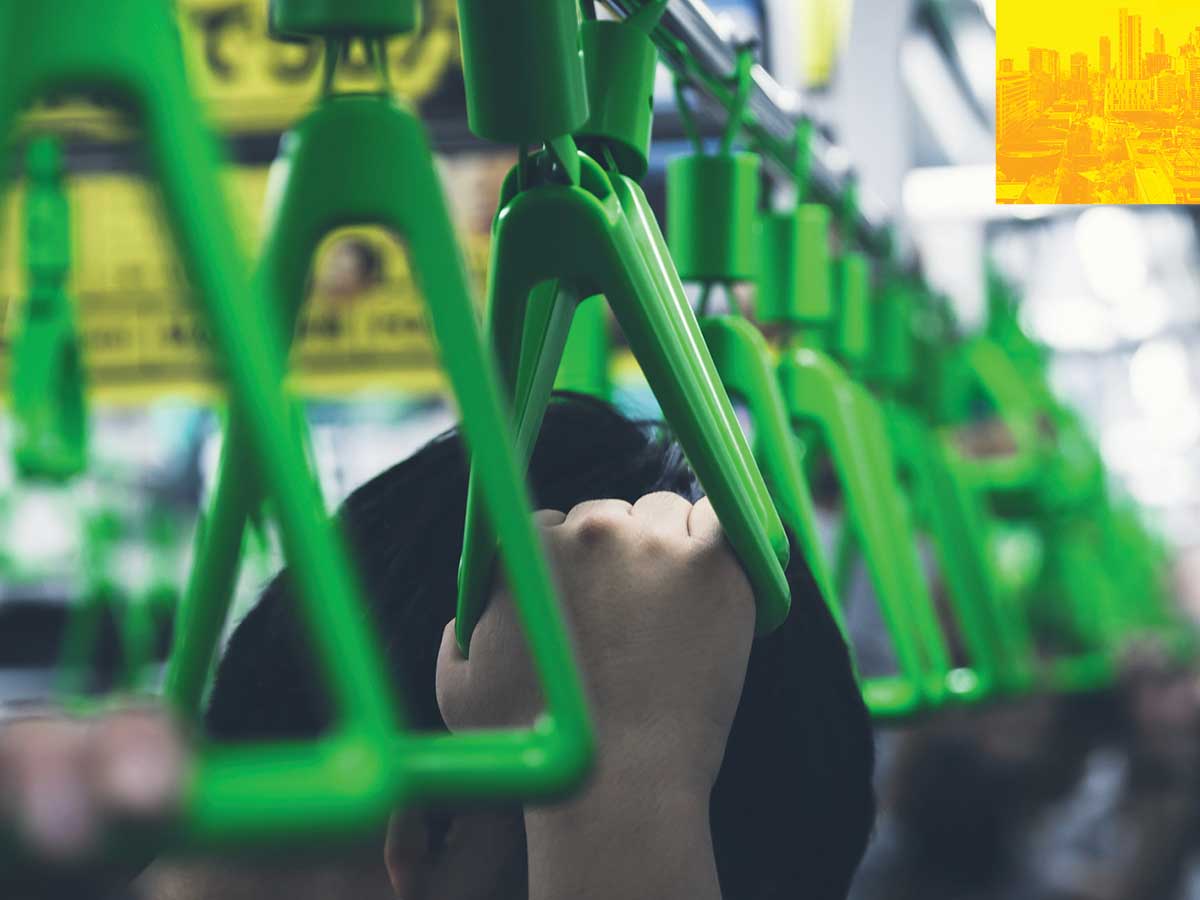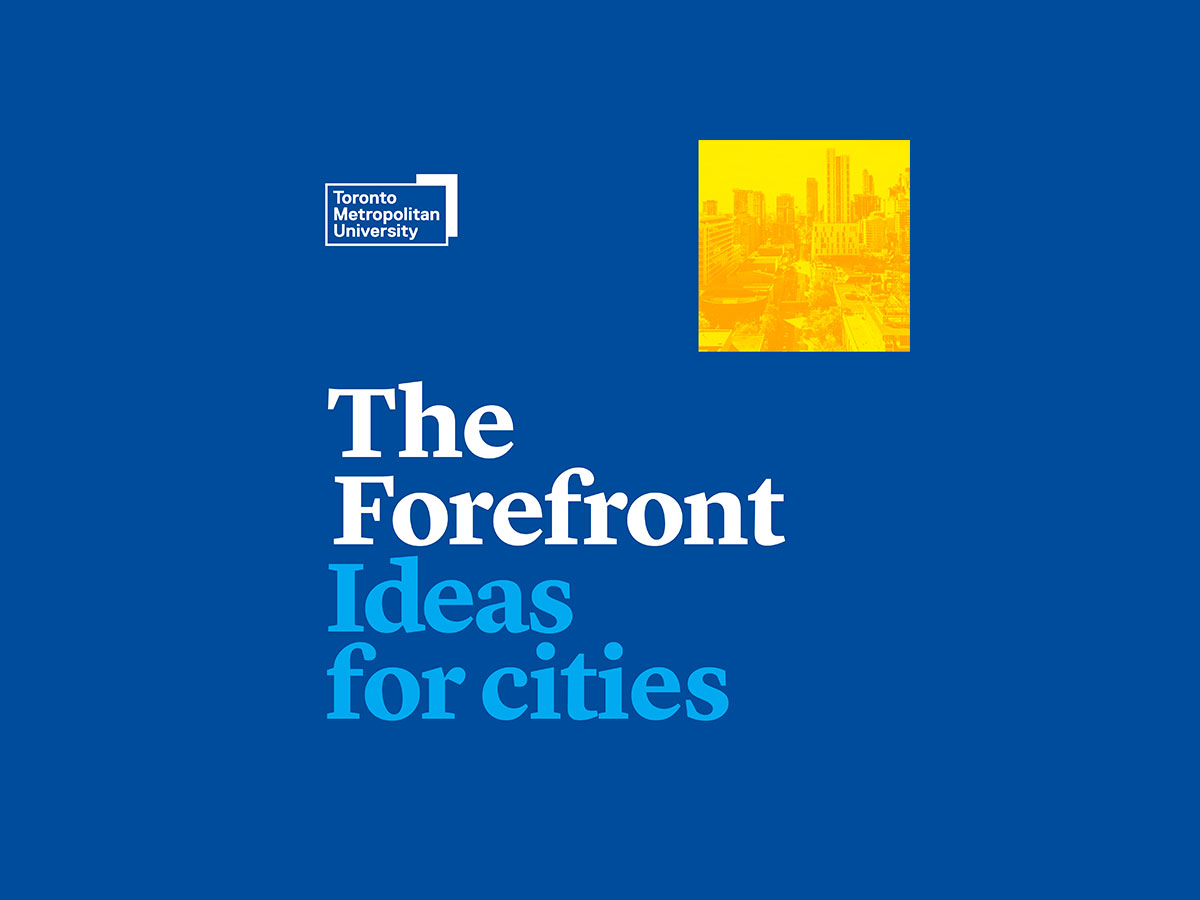Rethinking clean transportation

Season 3, Episode 6
Description
According to TMU’s Centre for Urban Energy (opens in new window) , by 2030, 80% of the world's population will live in urban areas, so the way we use energy will impact the way we live, work and grow as a community. This has many people — including TMU alumni, looking for alternative modes of transportation.
In this episode, we speak with two alumni entrepreneurs about their pursuit of cleaner transportation options and TMU expert Bilal Farooq about how cities can be designed to reduce emissions produced by cars.
Amanda: This is The Forefront, a Toronto Metropolitan University podcast that explores ideas for cities. I’m Amanda Cupido. So here’s the problem: a quarter of all greenhouse gas emissions come from transportation. And a lot of Canadians still rely heavily on their cars. On top of that… according to TMU’s Centre for Urban Energy, 80% of the world’s population will live in urban areas by 2030. That means, the way we use energy in cities will have an even bigger impact. It's got a lot of people thinking about how we can reduce emissions.
Jeff: I first started the journey in clean mobility, really, when I had a son, where, as he was just learning to walk, I saw young people around the world, taking the streets and really upset of the future that is being left behind.
Amanda: This is Jeff Prosserman, a TMU alum who’s been thinking about how to build more sustainable cities for a while now. His company, Voltpost, aims to turn existing lamp posts into charging stations for electric vehicles—or EVs.
Jeff: Given the climate crisis, I wanted to do something to make more of a positive impact for the next generation.
Amanda: Jeff bought an EV at the beginning of the pandemic because he was nervous about taking his toddler on public transit where he lives in Brooklyn, NY. But he immediately noticed a problem with his new car: it was really hard to find places to charge it.
Jeff: Came to the point where I recognized that nobody's going to get behind the wheel of an EV if they had to deal with how I was charging at that moment, which was one, going to a Brooklyn Museum parking lot that's paid, sitting there and waiting for your car to charge, or two, driving to New Jersey to a paid parking lot at a shopping mall, as a secondary option to sit there and charge. The third option being going into a parking lot, which charges 20 plus dollars an hour, which may have a charger, which you would have no reason to enter other than to charge.
Amanda: Even for someone who wants to be as environmentally conscious as possible, that’s a big ask.
Jeff: Across Canada and the US, there's just a lack of that convenient and affordable charging. And most people beyond the early adopters, like to really get this into the mainstream, aren't going to jump over if they have to deal with what I've encountered and all early adopters who don't have a house with a garage.So people want to do good, but then there's a level of effort. And when it becomes too much work or too expensive, then many people will as much as they want to do the right thing, ultimately choose what fits best into their life. So if we really want to have this green transition, then we have to think about sustainability from the lens as how do we really build a bridge between how people live their lives and creating that value. And what the green transition needs in order to decarbonize the economy.
Amanda: The way Jeff sees it, charging station lamp posts are the perfect solution. Voltpost uses existing infrastructure to make it easier for people to use a sustainable vehicle. But what if you don’t want to drive at all? Well, TMU has an alum for that, too. Meet Shoaib Ahmed
Shoaib: When I emigrated to Canada in 1989, public transit was our lifeline, was my lifeline. And it still is my lifeline. If I needed to go anywhere, if I needed to go to school, work, you know, to visit some people, I would take public transit because I did not own a car. Just like necessities that we have, which is you know, food, shelter, medicine, and so on and so forth. Transportation is an absolute necessity for us, and transportation are one of the biggest emitters of greenhouse gas emissions.
Amanda: In 2019, Shoaib launched a company called Scooty. Their goal is to make clean transportation more accessible by providing affordable, simple access to electric scooters, or e-scooters.
Shoaib: Transportation was always something that I thought could be improved, I just didn't know how.
Amanda: Shoaib first encountered e-scooters on a work trip to Washington, DC.
Shoaib: I wanted to go to the Smithsonian Museum and if you've been to that Washington DC area, there's a lot of one way street, there's a lot of street closures because of security blockages and so on and so forth. The walk to the Smithsonian I recall was very, very long. I turn on my Uber app and there was surge pricing on Uber. And I'm like, I don't want to pay for surge pricing. And I just saw someone go pass by me on an electric scooter. And it got me curious, like what is this thing? This thing? This looks really cool. And as soon as I got on it, I'm like, Oh, my God, why can't this why can’t we do this in Canada? Why can't we do this, do this in Ontario?
Amanda: Back in Toronto, Shoaib would normally have someone drive him to the subway station to get to work. But when he got back from that trip, he bought an e-scooter right away. His gears started going...
Shoaib: I'm like this is amazing if I can do this, I see hundreds and 1000s of people on a daily basis taking public transit. But you know, but if they can have a choice have a really neat way of moving from point A to point B and it just so happens that it is electric. Why not?
Amanda: The way he sees it, e-scooters are a win-win. They’re better for the environment than driving and they can help you save money on gas. Plus, I just have to add that they’re really fun to use! I tried one out when I was visiting Ottawa last year. I used the e-scooters throughout my entire trip rather than taking cabs.
Shoaib: I think clean transportation,it's about making choices. So when I had my electric scooter on me, or what I still do, I don't take my car if I need to go to if I need to go short distances. I just don't. And the other reason the other motivation, in addition to that is gas prices and cost of the cars have increased significantly this year. And they will continue to increase. So if I can save money, while being environmentally responsible, on small choices I can make then why not?
Amanda: It’s fascinating to think about all the ways new technology can change how we get around our cities. But we can't ignore the fact that not everyone is going to be up for ditching the cars they have now. That's why Dr. Bilal Farooq is looking at how cities can be designed differently so that cars are routed in a way that would use the least amount of emissions.
Bilal: If you are constantly breaking and accelerating, that will have much higher emission than let's say, you are driving at constant speed of let's say around 40-45 kilometres an hour. So, we we are trying to develop routing algorithms that can exploit these features of the of the vehicle operations and try to route vehicles such that they are emitting less emissions while they are operating.
Amanda: Dr. Farooq is an associate professor of engineering at TMU and a Canada Research Chair in Disruptive Transportation Technologies and Services and knows what it would take to make these sorts of changes…
Bilal: So cities like City of Toronto, we need infrastructure investment, that is related to sensing that is related to connectivity. And we need more adaptive sort of approaches towards traffic control especially into intersections. So these are some of the investments that we would need from the city.
Amanda: This kind of thinking and system level approach can be useful for other types of transportation too. For example, EVs.
Bilal: So if we electrify all our vehicles, what will happen is that the the emissions that are that were happening on the road, they will probably go away. But then that's not the end of the story. Because these vehicles, they need to be charged somewhere and they need to be charged somewhere that would result in some electricity demand and electricity need to be generated. So instead of all the greenhouse gas emissions that were previously generated downstream, now, they are being generated upstream at electricity generation level.
Amanda: Basically, if everyone needs to charge their EVs at once, the demand for electricity will be too high. And that means that we have to shift to less clean energy sources, like gas, to generate that electricity. Not ideal.
Bilal: So, we tried to look at how the charging schedules, how people's mobility patterns, they define the charging patterns and the electricity demand that is coming in, and how we can come up with planning of charging at the time of the day, such that the mobility patterns, they are not affected, but at the same time, we are using cleaner energy over the day.
Amanda: From Dr. Farooq’s perspective, the key is making sure people have options.
Bilal: As a transportation engineer, my basic aim always is to provide multiple options for people to move from point A to point B, and those multiple options should be equally competitive to to each other, and only then we are able to, you know, provide a robust transportation system.
Amanda: But he also says to think carefully about how you’re using those different options and why.
Bilal: For instance previously if people were walking and instead of walking they start using e-scooter that may not be a very good thing. We should be looking at you know reducing car-based trips, especially single occupancy trips, and if that mode can be substituted with a scooter for further trips that that would be better situation to be in. So we also need to look at that dimension.
Amanda: Shoaib agrees that each decision we make about transportation is important.
Shoaib: One of the things that we need to understand is there's a massive incremental effect of making collectively making small choices. If I make a small choice, you make a small choice, somebody else makes it makes a small choice, and so on and so forth. When you combine those small choices, collectively, that makes a significant impact. So if 10 people, as an example, are taking an electric bike, or electric scooter, or just a regular bike, to go from point A to point B, instead of taking a car or rideshare service, when they don't need to, times that by 10, 20, 30 100, that makes a very significant impact on the choices that we make.
Amanda: Jeff adds it’s all about the long game.
Jeff: I feel like we're in this unique moment in history, trying to make a positive impact. There's a limited window. And, frankly, we all live with our own level of stress about the future and if we're going to get there. But I always come back to this example. At least my centre of gravity of why I'm doing this is I came to a turning point where having a young son, recognizing that by 2050, or whatever period when he's the same age that I am now, I just wanted to be able to look in his eyes and say that I did everything I could to try and really make that impact. And I think whether you're a parent, or whether you're a young person, really, we need all hands on deck that we need everybody to be a part of this transition. So I just thank anybody who's willing to dedicate their life to this cause.
Amanda: Before we go, here are some final thoughts from Dr. Farooq about how TMU supports his research.
Bilal: I get to work on issues that I think are important, and the support that is required, whether it's in terms of space, my graduate students, or in terms of equipment. So TMU has ensured that all that support is available. And definitely, I mean, the, the ambitions that I brought in, they encouraged them, they encouraged for me to set goals that are extremely high and supported me in terms of achieving them. So definitely, it's a it's a great place in terms of doing cutting edge research. They there's the speed with which the support is made available, you know, that is that is very rare. The approach here is very lean in the sense that if something needs to happen, that happens very quickly and because of that, it encourages researchers like me to to work and be more ambitious about it.
Amanda: This podcast was created for alumni and friends by University Advancement at Toronto Metropolitan University. Special thanks to our guests on today’s episode: Jeff Prosserman Shoaib Ahmed and Dr. Bilal Farooq. This podcast was produced by me, Amanda Cupido and Emily Morantz. Katia Galati was the editor for the show. All of us are proud grads of TMU! To learn more about clean transportation, and for more episodes of this podcast and others, visit torontomu.ca/alumni/podcasts (opens in new window) .

The Forefront is a proud recipient of the Canadian Online Publishing Awards for Best Podcast in 2023 (silver).

The Forefront is a proud recipient of the Canadian Council for the Advancement of Education (CCAE) Prix d’Excellence Award.
